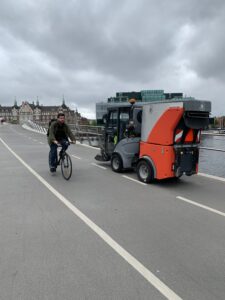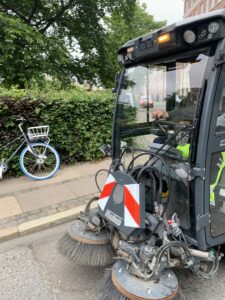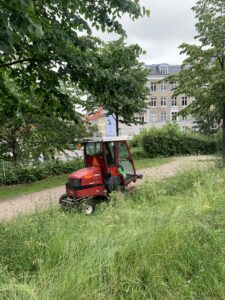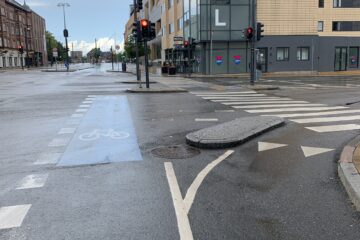
Street sweeper on a bike/ped bridge in Copenhagen
Copenhagen bike and pedestrian facility sweeper.

Close-up of the cab style bike lane-sized sweeper in Copenhagen.

Another example of the enclosed cab-style. This one is a Toro Groundsmaster and has a mower implement attached.
Any facility you own requires operations and on-going maintenance. In Copenhagen, their City works on the bicycling network and pedestrian network first – before the streets and portions of the network used by people driving.
- The rationale: They have such high mode usage, that there is no way the driving network – including transit (Metro light rail and buses) could handle the shift from walk/bike to drive, light rail, bus.
- 33% bike mode share
- 27% transit mode share
- 40% drive (some of these could be carpool)
With 45,000 bike trips on one critical bridge (the Queen Louise Bridge), you can get an idea of how many additional car trips they would need to handle in winter – their maintenance and planning departments have determined that they need to keep people riding through winter – so they do everything they can to keep people riding. One way is to begin winter storm operations on the bicycling and walking networks first, in a triaged route by route approach, then the roadway network, which is also critical to support transit.
75% of all commuters who ride bikes in summer continue to ride in winter. So they still need to accommodate 25% of summer biking trips with other modes – bus and light rail take up the slack, but so does driving – so often winter driving is more congested than summer driving.
Let’s see what Copenhagen is using right now in terms of equipment – climate-controlled cab small-sized sweepers and lawnmowers. These are really a game changer for operations. They are sized to fit on a sidewalk or in a protected bike lane. The City of Bend has been researching sweepers and snow plows that can be used for its network of protected bike lanes, bridge sidewalks, crosswalk safety islands, and shared use paths at roundabouts. They need machines that provide flexibility to handle different weather conditions and seasons. Bend needs machines that accommodate a variety of implements such as de-icing sprays and spray tanks, snow plowing when the snow is wet or heavy, and even snow blowers when snow conditions warrant, as well as lawn mowing needs at the cemetery. Bend has also looked at the Toro Groundsmaster for its price point and versatility of implements.
The City currently has just four walk-behind snow-blowers to tackle the snow on 43 sets of bridge sidewalks, 43 roundabouts, and 84 crosswalk safety islands. Much too few to get through that list in a timely manner so folks can get where they are going safely. The snow blowers are also residential, not heavy-duty. Crew time in the direct elements can limit operations when temperatures are too severe.
The machines that have an enclosed cab really extend the time the operator can be in the field during a winter shift. And these machines can also be driven site to site and don’t have to be trailered, definitely making operations more efficient.
The City of Bend’s Transportation System Plan identified different ways to fund on-going operations such as sweeping and snow and ice management. Having the right equipment and enough operators allows communities to get people moving after a winter storm, and keeps facilities clear of debris on a year-round basis.

3 Comments
carol higginbotham · June 23, 2022 at 11:10 pm
This is so important! In Bend especially where street plows heave slush and cinders into the sidewalks that abut the roads in winter.
David Green · July 11, 2022 at 3:04 am
Keep people riding in the winter! I hear so many people saying that’s why they don’t think bikes will ever be an important part of our transportation. But with these priorities, it could be!
Robin · July 11, 2022 at 7:26 pm
It is easy to get people riding year round, I think people forget that when you are moving your legs your body heats up so much. The key is to never break the habit. If you ride to school or work or shopping, or just even to the gym on Wednesdays for leg day – you just keep the habit going. It becomes part of that routine.